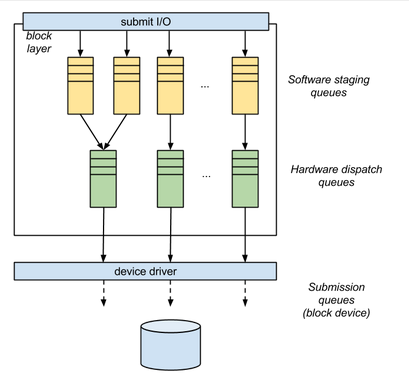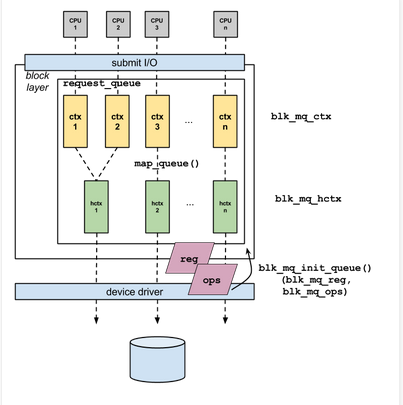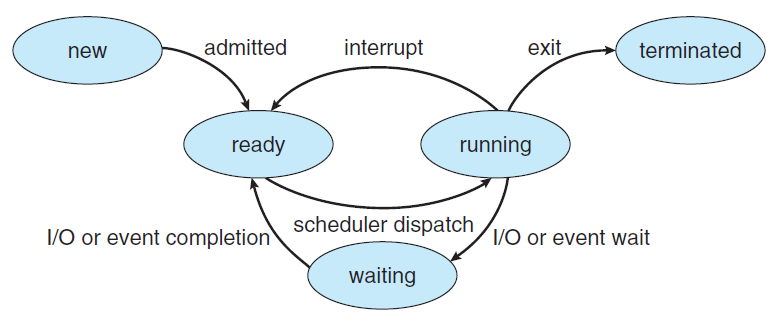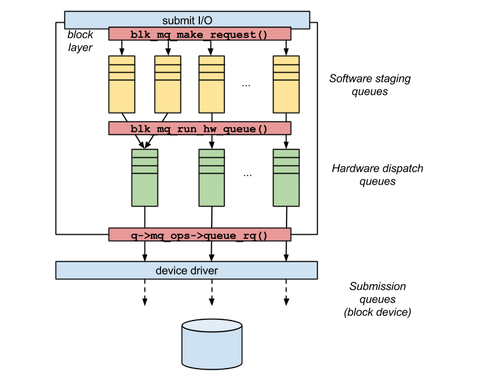Now, I’m interested in multi-block layer and open source.
So, this article is for me to study about multi queue,
This article is refered from one URL, The Multi-Queue Interface and NVM Express ver 1.2 specification
Also, I recommend this site,”Linux Kernel Newbies”. for kernel newvbies.
And If you want to see the linux kernel, Just click this site, Linux Kernel’s Version.
!!! So, If you want know why mutilqueu is good for SSD. Just try to read this
Multi Block layer
This multi queue layer’s summary is from The Multi-Queue Interface Article
Linux kernel git shows you conversion into blk-mq
The blk_mq API Implements a two-levels block layer design which use two separate sets of request queues.
software staging queues, allocated per-CPU
hardware dispatch queues, whose number typically match the number of actual haraware queues supported by th blcok device.

as you can see the above picture.
the number of mapped queues between software staging queues and hardware dispatch queues is different
Now, let’s think of case that two queue put differently.
let’s say, three cases are in here.
- software staging queues > hardware dispatch queues
In this case, two or more software staging queues is allocated to one of hardware context. And a dispatch is performed while the hardware context will pull requests in from all the associated software queues.
- software staging queue < hardware dispatch queues
In this case, mapping between software staging queues and hardware dispatch queues is sequential.
- software staging queue == hardware dispatch queue
In this case, this is the most simple case. i.e a direct 1 : 1 mapping is performed.
Main data structure in mulit-queue block layer.
Basic Archictecture

1. blk_mq_reg (in kernel 4.5)
according to The Multi-Queue Interface Article,
blk_mq_reg structure contains all of important information during the register of a new block device to the block layer.
This data structure includes the pointer to a blk_mq_ops data structure, used to keep track of the specific routines to be used by the multi-queue block layer to interact with the device’s driver.
blk_mq_reg structure also keeps the number of hardware queues to be initialized and so on.
** However, blk_mq_reg disappear.
I think I need to consider blk_mq_ops to understand operation between block layer and block device
So you can ckeck the data structure in kernel 3.15
52 struct blk_mq_reg {
53 struct blk_mq_ops *ops;
54 unsigned int nr_hw_queues;
55 unsigned int queue_depth;
56 unsigned int reserved_tags;
57 unsigned int cmd_size; /* per-request extra data */
58 int numa_node;
59 unsigned int timeout;
60 unsigned int flags; /* BLK_MQ_F_* */
61 };
But, In kernel 4.5, You can not check this data structure.
I think this data structure is changed to struct blk_mq_tag_set *set in kernel 4.5
67 struct blk_mq_tag_set {
68 struct blk_mq_ops *ops;
69 unsigned int nr_hw_queues;
70 unsigned int queue_depth; /* max hw supported */
71 unsigned int reserved_tags;
72 unsigned int cmd_size; /* per-request extra data */
73 int numa_node;
74 unsigned int timeout;
75 unsigned int flags; /* BLK_MQ_F_* */
76 void *driver_data;
77
78 struct blk_mq_tags **tags;
79
80 struct mutex tag_list_lock;
81 struct list_head tag_list;
82 };
Because, In kernel 3.15, function(struct request_queue *blk_mq_init_queue(struct blk_mq_reg *reg, void *driver_data)) is changed to function(struct request_queue *blk_mq_init_queue(struct blk_mq_tag_set *set))
2. blk_mq_ops structure(in kernel 4.5)
as you can read above, this data structure is used to communicate multi-queue block layer with the block device’s layer.
In this data structure, the function performing mapping contexts between the blk_mq_hw_ctx and the blk_mq_ctx is stored in map_queue field.
106 struct blk_mq_ops {
107 /*
108 * Queue request
109 */
110 queue_rq_fn *queue_rq; // this part
111
112 /*
113 * Map to specific hardware queue
114 */
115 map_queue_fn *map_queue; // this part
116
117 /*
118 * Called on request timeout
119 */
120 timeout_fn *timeout;
121
122 /*
123 * Called to poll for completion of a specific tag.
124 */
125 poll_fn *poll;
126
127 softirq_done_fn *complete;
128
129 /*
130 * Called when the block layer side of a hardware queue has been
131 * set up, allowing the driver to allocate/init matching structures.
132 * Ditto for exit/teardown.
133 */
134 init_hctx_fn *init_hctx;
135 exit_hctx_fn *exit_hctx;
136
137 /*
138 * Called for every command allocated by the block layer to allow
139 * the driver to set up driver specific data.
140 *
141 * Tag greater than or equal to queue_depth is for setting up
142 * flush request.
143 *
144 * Ditto for exit/teardown.
145 */
146 init_request_fn *init_request;
147 exit_request_fn *exit_request;
148 };
3. blk_mq_hw_ctx structure (in kernel 4.5)
blk_mq_hw_ctx structure represents the hardware context which a request_queue is associated to.
And this corresponding structure is the blk_mq_ctx structure.(in kernel 4.5)
21 struct blk_mq_hw_ctx {
22 struct {
23 spinlock_t lock;
24 struct list_head dispatch;
25 } ____cacheline_aligned_in_smp;
26
27 unsigned long state; /* BLK_MQ_S_* flags */
28 struct delayed_work run_work;
29 struct delayed_work delay_work;
30 cpumask_var_t cpumask;
31 int next_cpu;
32 int next_cpu_batch;
33
34 unsigned long flags; /* BLK_MQ_F_* flags */
35
36 struct request_queue *queue;
37 struct blk_flush_queue *fq;
38
39 void *driver_data;
40
41 struct blk_mq_ctxmap ctx_map;
42
43 unsigned int nr_ctx;
44 struct blk_mq_ctx **ctxs;
45
46 atomic_t wait_index;
47
48 struct blk_mq_tags *tags;
49
50 unsigned long queued;
51 unsigned long run;
52 #define BLK_MQ_MAX_DISPATCH_ORDER 10
53 unsigned long dispatched[BLK_MQ_MAX_DISPATCH_ORDER];
54
55 unsigned int numa_node;
56 unsigned int queue_num;
57
58 atomic_t nr_active;
59
60 struct blk_mq_cpu_notifier cpu_notifier;
61 struct kobject kobj;
62
63 unsigned long poll_invoked;
64 unsigned long poll_success;
65 };
4. blk_mq_ctx structure.(in kernel 4.5)
As you can read above, blk_mq_ctx as software staging queue is allocated per CPU.
6 struct blk_mq_ctx {
7 struct {
8 spinlock_t lock;
9 struct list_head rq_list;
10 } ____cacheline_aligned_in_smp;
11
12 unsigned int cpu;
13 unsigned int index_hw;
14
15 unsigned int last_tag ____cacheline_aligned_in_smp;
16
17 /* incremented at dispatch time */
18 unsigned long rq_dispatched[2];
19 unsigned long rq_merged;
20
21 /* incremented at completion time */
22 unsigned long ____cacheline_aligned_in_smp rq_completed[2];
23
24 struct request_queue *queue;
25 struct kobject kobj;
26 } ____cacheline_aligned_in_smp;
5. the request_queue structure (in kernel 4.5)
The mapping of contexts between between the blk_mq_hw_ctx and the blk_mq_ctx is built on map_queue field of blk_mq_ops structure. The mapping is kept as themq_map of request_queue data structure related to the block device in kernel 4.5
283 struct request_queue {
284 /*
285 * Together with queue_head for cacheline sharing
286 */
287 struct list_head queue_head;
288 struct request *last_merge;
289 struct elevator_queue *elevator;
290 int nr_rqs[2]; /* # allocated [a]sync rqs */
291 int nr_rqs_elvpriv; /* # allocated rqs w/ elvpriv */
292
293 /*
294 * If blkcg is not used, @q->root_rl serves all requests. If blkcg
295 * is used, root blkg allocates from @q->root_rl and all other
296 * blkgs from their own blkg->rl. Which one to use should be
297 * determined using bio_request_list().
298 */
299 struct request_list root_rl;
300
301 request_fn_proc *request_fn;
302 make_request_fn *make_request_fn;
303 prep_rq_fn *prep_rq_fn;
304 unprep_rq_fn *unprep_rq_fn;
305 softirq_done_fn *softirq_done_fn;
306 rq_timed_out_fn *rq_timed_out_fn;
307 dma_drain_needed_fn *dma_drain_needed;
308 lld_busy_fn *lld_busy_fn;
309
310 struct blk_mq_ops *mq_ops;
311
312 unsigned int *mq_map;
313
314 /* sw queues */
315 struct blk_mq_ctx __percpu *queue_ctx;
316 unsigned int nr_queues;
317
318 /* hw dispatch queues */
319 struct blk_mq_hw_ctx **queue_hw_ctx;
320 unsigned int nr_hw_queues;
321
322 /*
323 * Dispatch queue sorting
324 */
325 sector_t end_sector;
326 struct request *boundary_rq;
327
328 /*
329 * Delayed queue handling
330 */
331 struct delayed_work delay_work;
332
333 struct backing_dev_info backing_dev_info;
334
335 /*
336 * The queue owner gets to use this for whatever they like.
337 * ll_rw_blk doesn't touch it.
338 */
339 void *queuedata;
340
341 /*
342 * various queue flags, see QUEUE_* below
343 */
344 unsigned long queue_flags;
345
346 /*
347 * ida allocated id for this queue. Used to index queues from
348 * ioctx.
349 */
350 int id;
351
352 /*
353 * queue needs bounce pages for pages above this limit
354 */
355 gfp_t bounce_gfp;
356
357 /*
358 * protects queue structures from reentrancy. ->__queue_lock should
359 * _never_ be used directly, it is queue private. always use
360 * ->queue_lock.
361 */
362 spinlock_t __queue_lock;
363 spinlock_t *queue_lock;
364
365 /*
366 * queue kobject
367 */
368 struct kobject kobj;
369
370 /*
371 * mq queue kobject
372 */
373 struct kobject mq_kobj;
374
375 #ifdef CONFIG_BLK_DEV_INTEGRITY
376 struct blk_integrity integrity;
377 #endif /* CONFIG_BLK_DEV_INTEGRITY */
378
379 #ifdef CONFIG_PM
380 struct device *dev;
381 int rpm_status;
382 unsigned int nr_pending;
383 #endif
384
385 /*
386 * queue settings
387 */
388 unsigned long nr_requests; /* Max # of requests */
389 unsigned int nr_congestion_on;
390 unsigned int nr_congestion_off;
391 unsigned int nr_batching;
392
393 unsigned int dma_drain_size;
394 void *dma_drain_buffer;
395 unsigned int dma_pad_mask;
396 unsigned int dma_alignment;
397
398 struct blk_queue_tag *queue_tags;
399 struct list_head tag_busy_list;
400
401 unsigned int nr_sorted;
402 unsigned int in_flight[2];
403 /*
404 * Number of active block driver functions for which blk_drain_queue()
405 * must wait. Must be incremented around functions that unlock the
406 * queue_lock internally, e.g. scsi_request_fn().
407 */
408 unsigned int request_fn_active;
409
410 unsigned int rq_timeout;
411 struct timer_list timeout;
412 struct work_struct timeout_work;
413 struct list_head timeout_list;
414
415 struct list_head icq_list;
416 #ifdef CONFIG_BLK_CGROUP
417 DECLARE_BITMAP (blkcg_pols, BLKCG_MAX_POLS);
418 struct blkcg_gq *root_blkg;
419 struct list_head blkg_list;
420 #endif
421
422 struct queue_limits limits;
423
424 /*
425 * sg stuff
426 */
427 unsigned int sg_timeout;
428 unsigned int sg_reserved_size;
429 int node;
430 #ifdef CONFIG_BLK_DEV_IO_TRACE
431 struct blk_trace *blk_trace;
432 #endif
433 /*
434 * for flush operations
435 */
436 unsigned int flush_flags;
437 unsigned int flush_not_queueable:1;
438 struct blk_flush_queue *fq;
439
440 struct list_head requeue_list;
441 spinlock_t requeue_lock;
442 struct work_struct requeue_work;
443
444 struct mutex sysfs_lock;
445
446 int bypass_depth;
447 atomic_t mq_freeze_depth;
448
449 #if defined(CONFIG_BLK_DEV_BSG)
450 bsg_job_fn *bsg_job_fn;
451 int bsg_job_size;
452 struct bsg_class_device bsg_dev;
453 #endif
454
455 #ifdef CONFIG_BLK_DEV_THROTTLING
456 /* Throttle data */
457 struct throtl_data *td;
458 #endif
459 struct rcu_head rcu_head;
460 wait_queue_head_t mq_freeze_wq;
461 struct percpu_ref q_usage_counter;
462 struct list_head all_q_node;
463
464 struct blk_mq_tag_set *tag_set;
465 struct list_head tag_set_list;
466 struct bio_set *bio_split;
467
468 bool mq_sysfs_init_done;
469 };
Initialization of Queue
When a new devie driver using the multi-queue API is loaded, It creates and initializes a new blk_mq_ops structure and sets to its address the associated pointer of a new blk_mq_reg.
More In detail, except for the below structure, other operations are now strictly required,
But, other operations can be specified in order to perform specific operations on allocation of contexts or on completion of an I/O request.
As of necessary data, the driver must initialize the number of submission queues it supports, along with their size.
other data are required, to determine the size of the command supported by the driver and specific flags that must be exposed to the block layer.
BUT, in kernel version 4.5, struct blk_mq_tag_set is important, The above job is implemented in this struct blk_mq_tag_set.
queue_fn
this must be set to a function in charge of handling the command, for example, by passing the command to the low-level driver.
map_queue
performs the mapping between hardware and software context.
blk_mq_init_queue function (in kernel 4.5 source)
after getting ready for gendisk and request_queue related to the device. It(driver) invokes the blk_mq_init_queue function (in kernel 4.5 source)
This function intializes the hardware and software contexts and performs the mapping between them.
This intialization routine also sets an alternate make_request function, subsituting to the conventional request submission path which would includes the function blk_make_request() (in kernel 4.5 code) the multi-queue submission path(which includes, instead, blk_mq_make_request() (in kernel 4.5 code)).
In other words, the alternate make_request function is set with blk_queue_make_reqeust() helper.
Submission of Request
Device initialization substituted the conventional block I/O submission function with blk_mq_make_request() (in kernel 4.5 code), letting the multi-queue structures be used the perspective of the upper layer.
The make_request function (in kernel 4.5 no exist) used by the mutil-queue block layer includes the possibility to benefit from per-process plugging,But only for drivers supporting a single hardware queue or for async requests.

In case the request is sync and the driver actively uses the multi-queue interface, No plugging is performed.
if plugging is allowed, The make_request function also performs request merging, searching for a candidate first inside the task’s plug list,
And finally in the software queue mapped to current CPU, The submission path does not involve any I/O sheduling-related call-back.
Finally, make_request sends immediately to th correspoding hardware queue any sync request, While it delays this transition in cas of async or flush requests, to allow for subsequent merging and more efficient dispatching.
Request dispatch
In case that an I/O request is synchronous (and therefore no plugging is allowed for it form the multi-queue block layer)
Its dispatch to the device driver is performed int the context is performed in the context of the same request.
If the request is instead async or flush, Task plugging is present,
the dispatch is performed as The following timing :
1 - In the context of the submission of another I/O reqeust to a software queue associated to the same hardware queue
2 - When the delayed work scheduled during reqeust submission is executed.
The main run-of-queue function of the multi-queue block layer is the blk_mq_run_hw_queue() (in kernel 4.5 code) which basically depends on another driver-specific routine, pointed by the queue_rq (in kernel 4.5) field of its blk_mq_ops structure
!!I have to check relationship between blk_mq_run_hw_queue and request_qu!!
!!This function delays any run of queue for an async reqeust, While it dispatches a sync reqeuest immediately to the driver.
The inner function __blk_mq_run_hw_queue() (in kernel 4.5 code), called by blk_mq_run_hw_queue() (in kernel 4.5 code) in case the reqeust is sync, first joins any software queue associated to the currently-in-service hardware queue, Then it joins the resulting list with any entry already on the dispatch list.
After collecting all to-be-served entries, the function __blk_mq_run_hw_queue() (in kernel 4.5 code) processes them(entries), starting each reqeust and passing it on to the driver, with its queue_rq function.
The function finally handles possible errors, by requeue or deletion of the associated requests.
